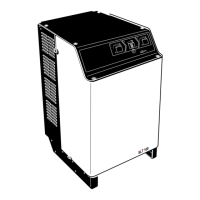6
1115.GB
D Battery - Servicing, recharging, replacement
1 Safety regulations governing the
handling of lead-acid batteries
Maintenance personnel:
Recharging, servicing and replacing of
batteries must only be performed by
qualified personnel. The instructions
contained in this operating manual, and the
instructions as prepared by the battery
supplier must be observed, when
performing the above operations.
F
Metal watch bracelets, bracelets and
necklaces must not be worn when handling
batteries!
Fire protection measures:
Smoking and open flames are not permitted
when handling batteries. There must be no
flammable substances within at least 2.5
metres and no equipment capable of
creating sparks (e.g. machine tools) within
at least a 1 metre radius of the truck when
it is parked for battery recharging. It is
forbidden to operate devices with a high
surface temperature (e.g. soldering irons,
heater blowers, etc.).
Place the charger only on a solid and
secure surface.
M
The surface must not consist of flammable
material.
F
Charging batteries leads to the generation
of explosive gases. Sufficient ventilation
must be provided during charging and at
least for one hour after charging has been
completed.
The room must be ventilated. Check the
ventilation system each time before you
charge. Fire fighting equipment must be
held ready.
M
Parts that can be sucked in due to the
suction of the ventilation fans must not be
stored in the vicinity of the battery charger.
Clogged ventilation slits cause overheating
and fire hazard.
F
Do not use water to cool overheated battery
chargers.
Battery servicing:
The battery cell screw caps must be kept
dry and clean. Terminals and cable shoes
must be clean, lightly greased with pole
grease and must be securely tightened.
F
Batteries contain dissolved acid, which is
toxic and caustic. For this reason protective
clothing and goggles must be worn
whenever work is undertaken on batteries.
Avoid physical contact with battery acid.
If clothing, skin or eyes accidentally come
into contact with battery acid, liberally rinse
the affected parts with clean water. If it has
come into contact with the skin or eyes,
seek medical attention. Spilled battery acid
should be neutralised immediately with
plenty of water.
11
1115.GB
F Charger Maintenance
1 Operational safety and environmental
protection
The SLT 100 charger is maintenance-free.
It does not need to be cleaned regularly.
F
Any modification to the SLT 100 charger, in
particular its safety mechanisms, is strictly
prohibited.
M
Only original spare parts have been passed
by our quality assurance service. In order to
ensure safe and reliable operation,
exclusively use spare parts supplied by the
manufacturer. Old parts, oils and fuels must
be disposed of in accordance with the
applicable environmental protection
regulations.
2 Safety instructions to be observed
during servicing
Maintenance personnel:
Maintenance and repair of SLT 100
chargers must only be carried out by
qualified personnel.
The manufacturer’s service department
has field technicians specially trained for
these tasks.
3 Cleaning operations
F
Disconnect the unit from the mains before
starting cleaning work.
Do not use flammable liquids to clean the
charger.
4 Working on the SLT 100 charger
F
Operations of any kind on the battery
chargers must only be performed by
qualified electricians. Prior to the
commencement of any work on a battery
charger, all required measures must be
taken to prevent electric shocks.
5 Fuses
Z
The fuses used depend on the model.
5.1 Small battery charger
- Primary:
F2 fuse (15)
- Secondary:
F1 fuse (16)
- electrolyte circulation pump/
Aquamatik (o):
F3 fuse (14)
M
Version and rated value of the fuses must
not be changed. Refer to label showing the
rated values.
15
F2
14
F3
16
F1

